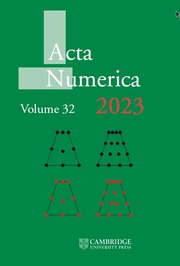No CrossRef data available.
Article contents
Time parallelization for hyperbolic and parabolic problems
Published online by Cambridge University Press: 01 July 2025
Abstract
Time parallelization, also known as PinT (parallel-in-time), is a new research direction for the development of algorithms used for solving very large-scale evolution problems on highly parallel computing architectures. Despite the fact that interesting theoretical work on PinT appeared as early as 1964, it was not until 2004, when processor clock speeds reached their physical limit, that research in PinT took off. A distinctive characteristic of parallelization in time is that information flow only goes forward in time, meaning that time evolution processes seem necessarily to be sequential. Nevertheless, many algorithms have been developed for PinT computations over the past two decades, and they are often grouped into four basic classes according to how the techniques work and are used: shooting-type methods; waveform relaxation methods based on domain decomposition; multigrid methods in space–time; and direct time parallel methods. However, over the past few years, it has been recognized that highly successful PinT algorithms for parabolic problems struggle when applied to hyperbolic problems. We will therefore focus on this important aspect, first by providing a summary of the fundamental differences between parabolic and hyperbolic problems for time parallelization. We then group PinT algorithms into two basic groups. The first group contains four effective PinT techniques for hyperbolic problems: Schwarz waveform relaxation (SWR) with its relation to tent pitching; parallel integral deferred correction; ParaExp; and ParaDiag. While the methods in the first group also work well for parabolic problems, we then present PinT methods specifically designed for parabolic problems in the second group: Parareal; the parallel full approximation scheme in space–time (PFASST); multigrid reduction in time (MGRiT); and space–time multigrid (STMG). We complement our analysis with numerical illustrations using four time-dependent PDEs: the heat equation; the advection–diffusion equation; Burgers’ equation; and the second-order wave equation.
Information
- Type
- Research Article
- Information
- Creative Commons
- This is an Open Access article, distributed under the terms of the Creative Commons Attribution licence (http://creativecommons.org/licenses/by/4.0/), which permits unrestricted re-use, distribution, and reproduction in any medium, provided the original work is properly cited.
- Copyright
- © The Author(s), 2025. Published by Cambridge University Press

